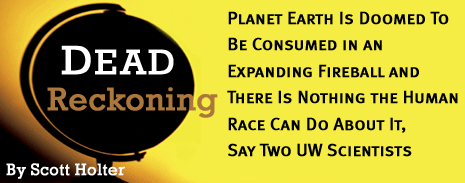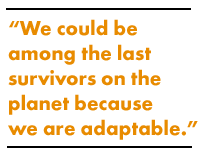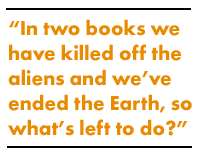
But should we care? If nothing else, it simply drives home the fact that we are all just a blip on the Earth's lifetime radar screen.
"Why should we care that the Earth is flat if it didn't matter 500 years ago?" Ward asks. "Do you have children? If so, your DNA is heading off toward that future. There's a good chance your DNA will be around when it does happen."
The unlikely literary coupling of the astronomer and the geologist began soon after Ward attended a Brownlee lecture on comets and meteorites of the solar system. Ward was already a prominent author of nine books, including the acclaimed The End of the Evolution, and conjured an instant paradigm: integrating his expertise of mass extinctions with Brownlee's proficiency for all things universe.
 Brownlee came with a decorated résumé. He is the principal investigator for Stardust, a seven-year NASA Discovery mission to capture comet particles and return them to Earth. Launched in February 1999 from Cape Canaveral, Fla., it is the first U.S. sample-return mission since Apollo 17 and the first ever designed to return material from outside the orbit of the moon.
Brownlee came with a decorated résumé. He is the principal investigator for Stardust, a seven-year NASA Discovery mission to capture comet particles and return them to Earth. Launched in February 1999 from Cape Canaveral, Fla., it is the first U.S. sample-return mission since Apollo 17 and the first ever designed to return material from outside the orbit of the moon.
"I went to Don with the proposal that we write a book together," Ward remembers. "We went to lunch, and by the time we got back to his office, we had a title."
Rare Earth was published early in 2000, laying out a synthesis that any life found on other planets is most likely to be crude microbes or the equivalent. Hailed in the New York Times, the London Times and Scientific American, Rare Earth reached No. 6 on Amazon's best-seller list.
But Ward says the follow-up to Rare Earth was anything but exact science. "Don just said, 'How about we write about the end of the world?' We put together an outline and split up the chapters with eenie meenie minie mo. In two books we have killed off the aliens and we've ended the Earth, so what's left to do?"
A study of the termination of the Earth is actually a study of the concept of the sun, which the authors describe as "a big ball of hydrogen gas with a nuclear reactor at its center."
A star much like others we see on the clearest nights, the sun plays a much bigger role in our everyday lives. We are held in orbit by its gravity. We don't freeze because of its heat. And we get food from plants thanks to the photosynthesis dependent on its energy-60 million watts of power for every square meter of its surface.
 Hydrogen fuses with hydrogen to make helium, a process that releases nuclear energy to power the sun. As the amount of helium in the sun rises, the sun's temperature also rises and it slowly becomes brighter.
Hydrogen fuses with hydrogen to make helium, a process that releases nuclear energy to power the sun. As the amount of helium in the sun rises, the sun's temperature also rises and it slowly becomes brighter.
"The temperature rises to keep the star stable against its own gravity," says Brownlee. "The energy production increases because the fusion rate of hydrogen to helium is dependent on temperature. The hotter the gas, the harder hydrogens collide and the more likely they will undergo nuclear reactions to make helium."
How slow is the process? Brownlee estimates that the hydrogen that exists in the center of the sun will last about 10 billion years before forming helium. In fact, all stars undergo the same process, becoming slowly brighter with time.
"The sun gets about 10 percent brighter every million years, which is about the equivalent of moving from Seattle to southern Oregon," Brownlee says. "The increasing heat affects the Earth's systems, such as the cycling of compounds between air, ocean and rock. The result is the decline of CO2 in the atmosphere.
"As the star get hotter, a water- and land-covered planet like Earth will have more and more of its CO2 put into carbonate rocks," he continues. "It is all due to chemical processes. The carbon in us came from a star. But the very process that kills the Earth makes carbon for new stars."
Go To: Page 1 | Page 2 | Page 3
Sidebar: Seeking Life on Other Worlds
- Return to September 2003 Table of Contents